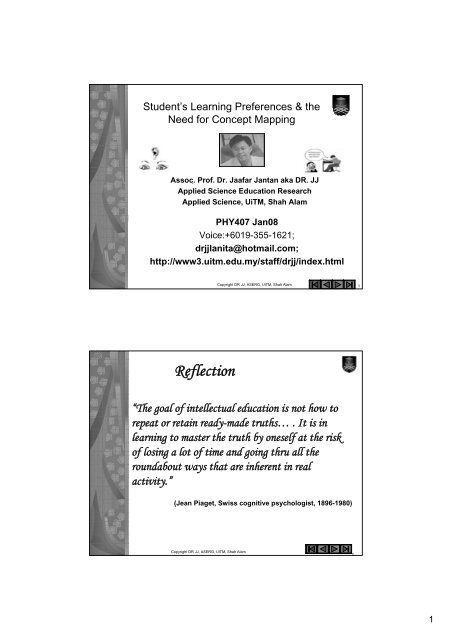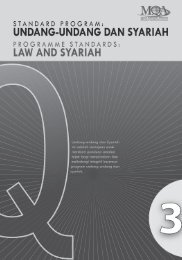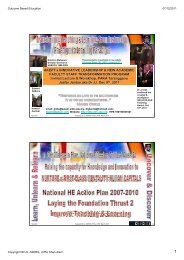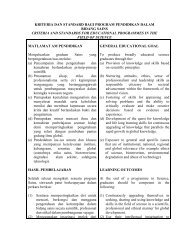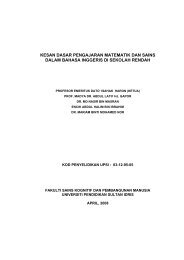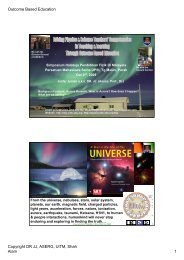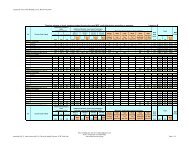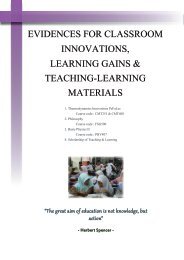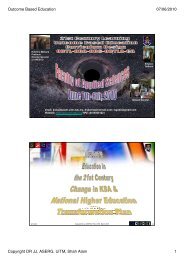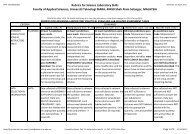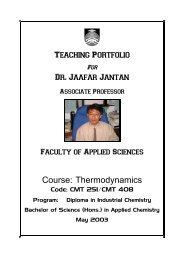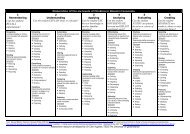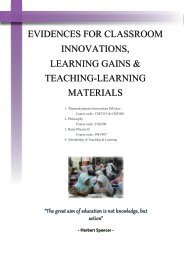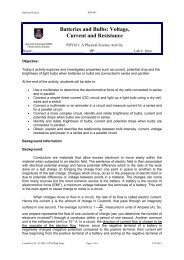CMAP - Dr JJ or Dr Jaafar Jantan Homepage - UiTM
CMAP - Dr JJ or Dr Jaafar Jantan Homepage - UiTM
CMAP - Dr JJ or Dr Jaafar Jantan Homepage - UiTM
You also want an ePaper? Increase the reach of your titles
YUMPU automatically turns print PDFs into web optimized ePapers that Google loves.
Student’s Learning Preferences & the<br />
Need f<strong>or</strong> Concept Mapping<br />
Assoc. . Prof. <strong>Dr</strong>. <strong>Jaafar</strong> <strong>Jantan</strong> aka DR. <strong>JJ</strong><br />
Applied Science Education Research<br />
Applied Science, <strong>UiTM</strong>, Shah Alam<br />
PHY407 Jan08<br />
Voice:+6019-355-1621;<br />
drjjlanita@hotmail.com;<br />
http://www3.uitm.edu.my/staff/drjj/index.html<br />
Copyright DR <strong>JJ</strong>, ASERG, <strong>UiTM</strong>, Shah Alam 1<br />
Reflection<br />
“The goal of intellectual education is not how to<br />
repeat <strong>or</strong> retain ready-made truths… . It is in<br />
learning to master the truth by oneself at the risk<br />
of losing a lot of time and going thru all the<br />
roundabout ways that are inherent in real<br />
activity.”<br />
(Jean Piaget, Swiss cognitive psychologist, 1896-1980)<br />
Copyright DR <strong>JJ</strong>, ASERG, <strong>UiTM</strong>, Shah Alam<br />
2<br />
1
The Math jargon (<strong>or</strong> conciseness)<br />
.<br />
Lava<br />
Wien’s<br />
Displacement Law<br />
λ<br />
max<br />
T<br />
= constant = 2.898×<br />
10<br />
−3<br />
mK<br />
Copyright DR <strong>JJ</strong>, ASERG, <strong>UiTM</strong>, Shah Alam 3<br />
Math Conciseness (<strong>or</strong> driving f<strong>or</strong>ce)<br />
Planck;s Law of blackbody radiation<br />
Total Power emitted by a black body<br />
.<br />
Total Power emitted by a<br />
black body<br />
Pnet<br />
Human body shielded by clothing:<br />
T body = 301K, T surr = 305K,emissivity<br />
=1, Area = 2 m 2<br />
Wien’s<br />
Displacement Law<br />
I( ν )<br />
P<br />
net<br />
= Aσε<br />
2hν<br />
2<br />
c<br />
=<br />
hν<br />
kT<br />
= P<br />
emit<br />
P net = 95W<br />
− P<br />
abs<strong>or</strong>b<br />
4 4<br />
( T −T<br />
)<br />
body<br />
3<br />
e<br />
1<br />
−1<br />
surr<br />
Copyright DR <strong>JJ</strong>, ASERG, <strong>UiTM</strong>, Shah Alam 4<br />
2
Reflection<br />
To those who do not know Mathematics it is<br />
difficult to get across a real feeling as to the<br />
beauty, the deepest beauty of nature. ... If you<br />
want to learn about nature, to appreciate nature,<br />
it is necessary to understand the language that she<br />
speaks in<br />
(Richard Feynman. 1918-1988.<br />
American physicist.<br />
The Character of Physical Law)<br />
Copyright DR <strong>JJ</strong>, ASERG, <strong>UiTM</strong>, Shah Alam 5<br />
“Universities are full of<br />
knowledge, the freshmen bring a<br />
little in and the seni<strong>or</strong>s take none<br />
away, and knowledge<br />
accumulates.” Abbot Lowell<br />
Copyright DR <strong>JJ</strong>, ASERG, <strong>UiTM</strong>, Shah Alam 6<br />
3
Copyright DR <strong>JJ</strong>, ASERG, <strong>UiTM</strong>, Shah Alam 7<br />
Understanding Inf<strong>or</strong>mation &<br />
Knowledge F<strong>or</strong>mation<br />
A car moving to the right with a velocity<br />
Descriptive<br />
20<br />
m/s crashed into a stationary l<strong>or</strong>ry. The<br />
total momentum must be conserved in<br />
the collision.<br />
Pict<strong>or</strong>ially/Graphically<br />
Symbolically:<br />
Mathematical<br />
representation<br />
p i = p f : (m 1 v 1 +m 2 v 2 ) i = (m 1 v 1 +m 2 v 2 ) f<br />
4
Know Yourself!!<br />
Learning Styles/preferences<br />
simplified MI<br />
“is the way in which each learner begins to<br />
concentrate on, process, and retain new<br />
and difficult inf<strong>or</strong>mation."(Dunn)<br />
Copyright DR <strong>JJ</strong>, ASERG, <strong>UiTM</strong>, Shah Alam 9<br />
What makes meaningful learning<br />
difficult- Learning Preferences<br />
Learning Styles<br />
"...a biologically and developmentally<br />
imposed set of personal characteristics<br />
that make the same teaching method<br />
effective f<strong>or</strong> some students and<br />
ineffective f<strong>or</strong> others,..." (Dunn,<br />
Beaudry, and Klavas, 1989)<br />
Copyright DR <strong>JJ</strong>, ASERG, <strong>UiTM</strong>, Shah Alam 10<br />
5
What makes meaningful learning<br />
difficult- Learning Preferences<br />
Felder’s Model - 4 domains of<br />
inf<strong>or</strong>mation handling: to understand<br />
new knowledge<br />
Input<br />
Understood<br />
New<br />
knowledge<br />
Processed<br />
Perceived<br />
ILS<br />
Copyright DR <strong>JJ</strong>, ASERG, <strong>UiTM</strong>, Shah Alam 11<br />
Student’ Learning Preferences:<br />
Inf<strong>or</strong>mation Handling Domains<br />
(Felder’s)<br />
*USA findings, ** DR. J.J’s (N = 1122)<br />
Visual<br />
Verbal<br />
Input<br />
*69, ** 87<br />
prefer charts, diagrams and<br />
pictures.<br />
*30, ** 13<br />
Sensing<br />
prefer data and facts. like<br />
facts & solve well establish<br />
methods, resent being tested<br />
on materials that has not<br />
been explicitly covered in<br />
class<br />
Intuitive<br />
Perception<br />
*57, ** 58<br />
*42, ** 42<br />
ILS<br />
prefer the spoken <strong>or</strong> written<br />
w<strong>or</strong>d.<br />
prefer the<strong>or</strong>ies &<br />
interpretations of factual<br />
inf<strong>or</strong>mation.<br />
Copyright DR <strong>JJ</strong>, ASERG, <strong>UiTM</strong>, Shah Alam 12<br />
6
Students’ Learning Preferences:<br />
Inf<strong>or</strong>mation Handling Domains<br />
(Felder’s)<br />
*USA findings, ** DR J.J.’s (N = 1122)<br />
Processing<br />
Understanding<br />
Active<br />
*67, **60<br />
Sequential<br />
*71, ** 60<br />
learn best by doing<br />
something physical with<br />
the inf<strong>or</strong>mation<br />
Reflective<br />
*32, ** 40<br />
easily make linear connections<br />
between individual steps<br />
Global<br />
*28, ** 40<br />
do the processing in<br />
their heads<br />
must get “big picture” bef<strong>or</strong>e<br />
individual pieces fall into place<br />
ILS<br />
Copyright DR <strong>JJ</strong>, ASERG, <strong>UiTM</strong>, Shah Alam 13<br />
Research on Learning Preferences<br />
Implications:<br />
Percentage of Students' Preferences Addressed By the<br />
Traditional Passive Lecture Method<br />
% of students<br />
80<br />
60<br />
40<br />
20<br />
0<br />
Reflective Intuitive Verbal Sequential<br />
Learning Preferences<br />
USA<br />
This w<strong>or</strong>k<br />
ILS<br />
Copyright DR <strong>JJ</strong>, ASERG, <strong>UiTM</strong>, Shah Alam 14<br />
7
Research on Learning Preferences<br />
Implications:<br />
Percentage of Students' Preferences Addressed by the<br />
Traditional Passive Lecture Method Acc<strong>or</strong>ding to CGPA<br />
% of students<br />
70<br />
60<br />
50<br />
40<br />
30<br />
20<br />
10<br />
0<br />
Reflective Intuitive Verbal Sequential<br />
Learning Preferences<br />
Less than 2: N=12<br />
Less than 3: N=90<br />
Less than 4: N=49<br />
ILS<br />
Copyright DR <strong>JJ</strong>, ASERG, <strong>UiTM</strong>, Shah Alam 15<br />
8
Reflection<br />
Copyright DR <strong>JJ</strong>, ASERG, <strong>UiTM</strong>, Shah Alam 17<br />
9
Copyright DR <strong>JJ</strong>, ASERG, <strong>UiTM</strong>, Shah Alam<br />
19<br />
What is a Concept<br />
Map<br />
Copyright DR <strong>JJ</strong>, ASERG, <strong>UiTM</strong>, Shah Alam 20<br />
10
What is a Concept<br />
Map<br />
Copyright DR <strong>JJ</strong>, ASERG, <strong>UiTM</strong>, Shah Alam 21<br />
Copyright DR <strong>JJ</strong>, ASERG, <strong>UiTM</strong>, Shah Alam 22<br />
11
Meaningful Vs Rote Learning<br />
Copyright DR <strong>JJ</strong>, ASERG, <strong>UiTM</strong>, Shah Alam 23<br />
Key<br />
Mem<strong>or</strong>y<br />
Systems &<br />
How they<br />
Interact<br />
Copyright DR <strong>JJ</strong>, ASERG, <strong>UiTM</strong>, Shah Alam 24<br />
12
Key<br />
Mem<strong>or</strong>y<br />
Systems &<br />
How they<br />
Interact<br />
Copyright DR <strong>JJ</strong>, ASERG, <strong>UiTM</strong>, Shah Alam 25<br />
What is a Concept Map<br />
A concept map is a special f<strong>or</strong>m of a web diagram<br />
f<strong>or</strong> expl<strong>or</strong>ing knowledge and gathering and sharing<br />
inf<strong>or</strong>mation. Concept mapping is the strategy<br />
employed to develop a concept map. A concept<br />
map consists of nodes <strong>or</strong> cells that contain a<br />
concept, item <strong>or</strong> question and links. The links are<br />
labeled and denote direction with an arrow head.<br />
The labeled links explain the relationship between<br />
the nodes. The arrow describes the direction of<br />
the relationship and reads like a n<strong>or</strong>mal sentence.<br />
Copyright DR <strong>JJ</strong>, ASERG, <strong>UiTM</strong>, Shah Alam<br />
26<br />
13
<strong>CMAP</strong><br />
Example: What is a a <strong>CMAP</strong><br />
<strong>CMAP</strong><br />
represents<br />
Organized<br />
knowledge<br />
Are/is<br />
concepts<br />
f<strong>or</strong>ms<br />
propositions<br />
Context<br />
dependent<br />
are<br />
Perceived<br />
regularities<br />
Are<br />
necessary f<strong>or</strong><br />
Effective<br />
learning<br />
<strong>CMAP</strong><br />
Why do Concept Maps<br />
‣to <strong>or</strong>ganize material<br />
‣ to assess understanding <strong>or</strong> diagnose<br />
misunderstanding<br />
‣ to communicate complex ideas<br />
‣ to generate ideas (brain st<strong>or</strong>ming, etc.);<br />
to design a complex structure (long texts,<br />
hypermedia, large web sites, etc.);<br />
Copyright DR <strong>JJ</strong>, ASERG, <strong>UiTM</strong>, Shah Alam 28<br />
14
<strong>CMAP</strong><br />
Why do Concept Maps<br />
‣ to integrate large body of materials<br />
‣ to insert new concepts within existing knowledge<br />
structure<br />
‣ to fix learned materials into long-term mem<strong>or</strong>y<br />
to revise effectively f<strong>or</strong> examinations<br />
Copyright DR <strong>JJ</strong>, ASERG, <strong>UiTM</strong>, Shah Alam 29<br />
<strong>CMAP</strong><br />
How To Do Concept Maps<br />
‣ Begin with domain of knowledge that<br />
is familiar<br />
‣ Identify segment of text <strong>or</strong> lab activity<br />
<strong>or</strong> a particular problem <strong>or</strong> question<br />
that you are trying to understand.<br />
‣ Identify key concepts in this domain by<br />
listing them.<br />
Copyright DR <strong>JJ</strong>, ASERG, <strong>UiTM</strong>, Shah Alam 30<br />
15
<strong>CMAP</strong><br />
Concept Maps Examples<br />
‣ What is a f<strong>or</strong>ce<br />
FORCE<br />
‣ Touch, at-a-distance ‣ Push, pull, frictional<br />
‣ Gravitational, magnetic, electrical ‣ field<br />
‣ Charge, mass, radius, length, time interval<br />
‣ Newton’s Laws, motion<br />
‣ Acceleration, linear, angular<br />
‣ Velocity, position, position change, clock reading<br />
‣ Inertia, moment of inertia, t<strong>or</strong>que<br />
‣ Newton, meter, seconds, radians<br />
Copyright DR <strong>JJ</strong>, ASERG, <strong>UiTM</strong>, Shah Alam 31<br />
<strong>CMAP</strong><br />
A Wave is<br />
Wave<br />
Concepts<br />
Wave<br />
<strong>CMAP</strong><br />
Party<br />
Water<br />
Ripples,<br />
Boats<br />
Sound<br />
Interference<br />
amplitude,<br />
Frequency<br />
Copyright DR <strong>JJ</strong>, ASERG, <strong>UiTM</strong>, Shah Alam 32<br />
16
Brainst<strong>or</strong>m/list out concepts<br />
Copyright DR <strong>JJ</strong>, ASERG, <strong>UiTM</strong>, Shah Alam 33<br />
<strong>CMAP</strong><br />
How To Do Concept Maps<br />
A Wave is<br />
Wave<br />
Concepts<br />
Wave<br />
<strong>CMAP</strong><br />
‣ Approximately, rank <strong>or</strong>der the concepts<br />
from most general most inclusive to<br />
most specific least general concept<br />
‣ Construct a preliminary concept map.<br />
Best done by writing concepts on<br />
sticker notes f<strong>or</strong> ease of moving it<br />
around during building the hierarchy.<br />
‣ Revise the map - m<strong>or</strong>e than 3X<br />
Copyright DR <strong>JJ</strong>, ASERG, <strong>UiTM</strong>, Shah Alam 34<br />
17
Rank the concepts<br />
General to specific<br />
Copyright DR <strong>JJ</strong>, ASERG, <strong>UiTM</strong>, Shah Alam 35<br />
<strong>CMAP</strong><br />
How To Do Concept Maps<br />
‣ Find the cross-links (concepts linked<br />
across domains)<br />
‣ Add domains and m<strong>or</strong>e cross-links every<br />
time new knowledge is learned.<br />
Copyright DR <strong>JJ</strong>, ASERG, <strong>UiTM</strong>, Shah Alam 36<br />
18
Copyright DR <strong>JJ</strong>, ASERG, <strong>UiTM</strong>, Shah Alam 37<br />
Copyright DR <strong>JJ</strong>, ASERG, <strong>UiTM</strong>, Shah Alam 38<br />
19
Copyright DR <strong>JJ</strong>, ASERG, <strong>UiTM</strong>, Shah Alam 39<br />
<strong>CMAP</strong>-Your task<br />
Construct a<br />
<strong>CMAP</strong><br />
Copyright DR <strong>JJ</strong>, ASERG, <strong>UiTM</strong>, Shah Alam 40<br />
20
What is a Concept Map<br />
<strong>CMAP</strong><br />
Example: Hierarchical Concept Maps<br />
Your Assignment: Group-w<strong>or</strong>k<br />
Focus Question: What is a f<strong>or</strong>ce<br />
‣Brainst<strong>or</strong>m at least 20 concepts associated with the<br />
question.<br />
‣Rank-<strong>or</strong>der them hierarchically with the question being at<br />
the top and the m<strong>or</strong>e specific concepts at the bottom.<br />
‣Write each concept on a piece of post-it and place them on<br />
a mahjung paper acc<strong>or</strong>ding to the hierarchy. Now link up<br />
the concepts by writing down the linkw<strong>or</strong>ds and drawing<br />
the arrowheads. You are now mapping the concepts.<br />
‣REVISE, REVISE, REVISE<br />
21
<strong>CMAP</strong><br />
Example: Hierarchical Concept Maps<br />
Your Take-home Assignment: Group-w<strong>or</strong>k<br />
Focus Question: What is electrostatics<br />
‣Brainst<strong>or</strong>m at least 20 concepts associated with the<br />
question.<br />
‣Rank-<strong>or</strong>der them hierarchically with the question being at<br />
the top and the m<strong>or</strong>e specific concepts at the bottom.<br />
‣You are now mapping the concepts.<br />
‣Submit at the beginning of next class.<br />
‣REVISE, REVISE, REVISE<br />
Conclusion<br />
"One who learns by finding out has sevenfold<br />
the skill of the one who learned by being told.“<br />
- Arthur Gutterman<br />
"The roots of education are bitter, but the fruit is<br />
sweet." -Aristotle<br />
IHMC<br />
22
<strong>CMAP</strong><br />
Concept Maps Activities<br />
Chemical Bonding<br />
Electro-chemistry<br />
Photon<br />
Photon<br />
Light<br />
Light<br />
Electromagnetic Induction<br />
Copyright DR <strong>JJ</strong>, ASERG, <strong>UiTM</strong>, Shah Alam 45<br />
23


